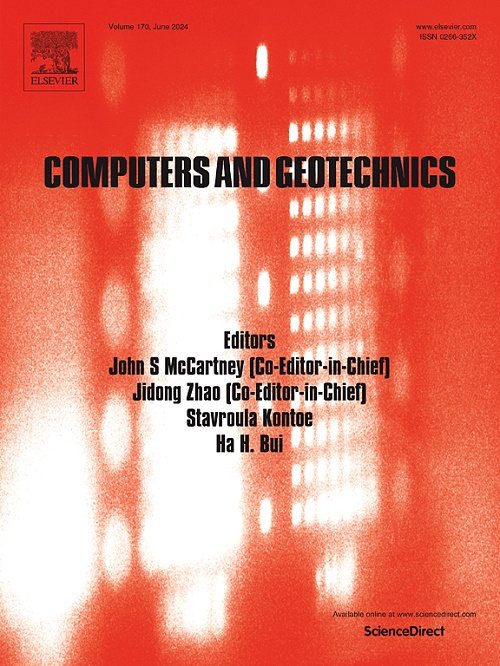Seismic bearing capacity of foundations incorporating excess pore water pressure generation during an earthquake
IF 5.3
1区 工程技术
Q1 COMPUTER SCIENCE, INTERDISCIPLINARY APPLICATIONS
引用次数: 0
Abstract
Considering the occurrence of an earthquake, the bearing capacity of a strip footing placed on a saturated cohesive-frictional soil mass has been computed by performing a pseudo-static rigorous analysis incorporating the existence of (i) excess pore water pressures, and (ii) additional seismic- tractions and body forces. The analysis has been carried out by using lower and upper bounds finite elements limit analysis (FELA) in conjunction with the second order cone programming (SOCP) using the Mohr-Coulomb (MC) yield criterion. The generation of the excess pore water pressure in the event of an earthquake has been incorporated by defining a pore pressure coefficient − a ratio of the excess pore water pressure to the total vertical overburden stress at any point. The analysis has revealed that the bearing capacity reduces considerably with an increase in the magnitude of horizontal earthquake acceleration. For a given magnitude of earthquake acceleration, the bearing capacity reduces extensively further with an increase in the value of ru. All the computational results have been presented in a non-dimensional manner, and for the validation purpose, necessary comparisons have also been made. The study will be useful for designing foundations in a seismically active zone.
考虑地震中产生的超孔隙水压力的地基抗震承载力
考虑到地震的发生,通过拟静力严格分析计算了饱和黏结-摩擦土体上条形基础的承载力,并考虑了(i)超孔隙水压力和(ii)附加地震牵引力和体力的存在。利用Mohr-Coulomb (MC)屈服准则,结合二阶锥规划(SOCP),采用上下界有限元极限分析(FELA)进行了分析。通过定义孔隙压力系数ru -超孔隙水压力与任意点的总垂向覆盖层应力之比,将地震中超孔隙水压力的产生纳入考虑范围。分析表明,随着水平地震加速度震级的增加,其承载能力明显降低。在地震加速度一定的情况下,随着ru值的增大,承载能力进一步大幅度降低。所有的计算结果都以无量纲的方式呈现,为了验证目的,还进行了必要的比较。该研究对地震活跃带地基设计具有一定的指导意义。
本文章由计算机程序翻译,如有差异,请以英文原文为准。
求助全文
约1分钟内获得全文
求助全文
来源期刊

Computers and Geotechnics
地学-地球科学综合
CiteScore
9.10
自引率
15.10%
发文量
438
审稿时长
45 days
期刊介绍:
The use of computers is firmly established in geotechnical engineering and continues to grow rapidly in both engineering practice and academe. The development of advanced numerical techniques and constitutive modeling, in conjunction with rapid developments in computer hardware, enables problems to be tackled that were unthinkable even a few years ago. Computers and Geotechnics provides an up-to-date reference for engineers and researchers engaged in computer aided analysis and research in geotechnical engineering. The journal is intended for an expeditious dissemination of advanced computer applications across a broad range of geotechnical topics. Contributions on advances in numerical algorithms, computer implementation of new constitutive models and probabilistic methods are especially encouraged.
 求助内容:
求助内容: 应助结果提醒方式:
应助结果提醒方式:


